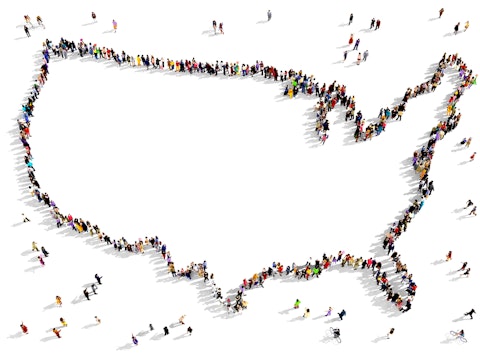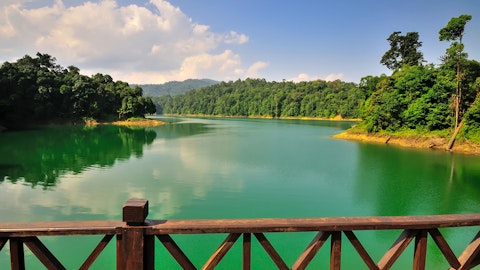In this article, we will take a look at the 20 least densely populated states in the US. If you would like to skip our discussion on the population trends in the US, you can go to the 5 Least Densely Populated States in the US.
The United States of America has the third largest population in the world, accounting for roughly 4.23% of the global population. The population density in the US stands at 36 people per square kilometer, which is considerably lower than densely populated countries like China and India. Population distribution across the US varies significantly. For instance, New Jersey and Rhode Island have population densities of 1263 and 1061.4 people per square mile, respectively, ranking them among the most densely populated states. Conversely, Wyoming is among the states with low population densities, at 5.9 people per square mile.
Typically, Northeastern states like Massachusetts and Connecticut are densely populated, with population densities as high as 901.2 and 744.1 people per square mile, respectively. In contrast, Midwestern states and certain Southern states such as Mississippi, Kansas, Minnesota, and North Dakota tend to have lower population densities. This disparity is attributed to factors such as greater land availability, fewer urban centers, and more sparsely populated areas in these regions.
Urban Population Dynamics
Large urban centers are more densely populated in the USA. According to the US Census Bureau, the overall population density of urbanized areas sits at approximately 2,534.4 people per square mile. This national figure, however, masks significant variations. Megacities like New York City have densities exceeding 27,000 people per square mile, reflecting a concentration of towering skyscrapers, bustling commercial districts, and limited land availability. Many major cities like Chicago and Philadelphia fall within a 10,000 to 20,000 people per square mile range, offering a balance between urban facilities and breathing room. In comparison, population densities in suburban areas can be significantly lower, sometimes dropping below 1,000 people per square mile.
Several factors contribute to the high population density in urban areas. One of these factors is the availability of job opportunities and the presence of popular companies like Apple Inc. (NASDAQ:AAPL), Microsoft Corporation (NASDAQ:MSFT), and NVIDIA Corporation (NASDAQ:NVDA). Job growth is increasing in major US cities while the workforce is decreasing in rural areas. In fact, there has been a larger decrease in workforce participation in non-metro areas, leading to a slower recovery from the COVID-19 recession. Studies, such as those conducted by the Manhattan Institute, highlight the presence of education and cultural centers, infrastructure, diverse services, transportation access, and healthcare availability as factors contributing to the concentration of population in urban areas.
However, urban areas face their fair share of challenges that lead individuals to relocate to the suburbs. A major issue is the lack of affordable housing. High demand in dense areas can outstrip housing supply, pushing up rents and homeownership costs, potentially leading to gentrification and displacement of low-income residents. A report by the National Low Income Housing Coalition found that a full-time minimum wage worker cannot afford a two-bedroom rental apartment in a major city, highlighting the affordability challenges in dense areas.

Arthimedes/Shutterstock.com
Our Methodology
We made a list of the 20 least densely populated states in the US, using average population per square mile data from the US Census Bureau. The states are ranked in descending order based on their population densities. We have also included the latest annual GDP per capita for each state to offer insights into their economies.
By the way, Insider Monkey is an investing website that tracks the movements of corporate insiders and hedge funds. By using a consensus approach, we identify the best stock picks of more than 900 hedge funds investing in US stocks. The top 10 consensus stock picks of hedge funds outperformed the S&P 500 Index by more than 140 percentage points over the last 10 years (see the details here). Whether you are a beginner investor or a professional one looking for the best stocks to buy, you can benefit from the wisdom of hedge funds and corporate insiders.
20 Least Densely Populated States in the US
20. West Virginia
Population Density per Square Mile: 74.6
GDP per Capita: $53,852
With a population density of 74.6 people per square mile, West Virginia is one of the least densely populated states in the US. Even the most densely populated area of the state, Charleston, has a population of merely 52,000. West Virginia has a GDP per capita of $53,832, with its economy based on industries such as mining and manufacturing. The state’s economy heavily relies on mining since it has major reserves of coal, oil, natural gas, and rock salt.
19. Minnesota
Population Density per Square Mile: 71.7
GDP per Capita: $78,100
Minnesota, known as ‘The land of 10,000 lakes,’ is a sparsely populated state in the US, with a population density of 71.7 people per square mile. Minnesota relies on agricultural exports to drive its economy. The state’s top five export commodities – soybeans, corn, livestock products, wheat, and processed vegetables – collectively make up 83% of all agricultural exports.
18. Vermont
Population Density per Square Mile: 69.8
GDP per Capita: $62,771
Vermont has a low population density of 69.8 people per square mile, with a total population of only 643,077. The state’s GDP per capita is $62,771. Vermont’s economy depends mainly on tourism, thanks to its blend of farms and mountains, making it an attractive destination for road trips. Despite its popularity among tourists, Vermont has one of the smallest economies among US states.
17. Mississippi
Population Density per Square Mile: 63.1
GDP per Capita: $47,190
Mississippi has a total population of 2,961,279. The Greater Jackson area is the state’s most populated metropolitan area. The GDP per capita in Mississippi is $47,190, and agriculture is the major industry. Agriculture contributes significantly to the state’s economy, with an industry value of $8.76 billion. Cotton is the primary crop cultivated and exported from Mississippi.
16. Arkansas
Population Density per Square Mile: 57.9
GDP per Capita: $54,259
Arkansas has a population density of just 57.9 people per square mile. The GDP per capita stands at $54,259, with commerce and agriculture serving as the major industries. Arkansas hosts six Fortune 500 companies, including Walmart. The state is a significant exporter of various agricultural products such as rice, soybeans, cotton, poultry, and feed grains.
15. Oklahoma
Population Density per Square Mile: 57.7
GDP per Capita: $59,894
Oklahoma has a low population density of 57.7 people per square mile. Meanwhile, the GDP per capita stands at $59,894. The largest industries by revenue in Oklahoma include Oil Drilling and Gas Extraction, Gasoline and Petroleum Wholesaling, and Hospitals, which generated $74.0 billion, $18.0 billion, and $15.2 billion, respectively, in 2023.
14. Colorado
Population Density per Square Mile: 55.7
GDP per Capita: $59,894
Colorado ranks as the eighth largest state in terms of area and the 21st most populous in the United States, with an estimated population of 5,773,714. Despite its expansive size, Colorado maintains a relatively low population density of only 55.7 individuals per square mile. According to a study by CNBC, Colorado ranks 11th among the top states for business in the US, hosting operations of prominent companies like Apple Inc. (NASDAQ:AAPL), Microsoft Corporation (NASDAQ:MSFT), and NVIDIA Corporation (NASDAQ:NVDA).
13. Maine
Population Density per Square Mile: 44.2
GDP per Capita: $61,008
Maine, located in the northeastern United States, has a modest population density of only 44.2 individuals per square mile. The state’s population is 1,362,359, with its largest city being Portland. With a per capita income of $61,008, Maine’s primary industry revolves around real estate, rentals, and leasing.
12. Oregon
Population Density per Square Mile: 44.1
GDP per Capita: $70,548
Oregon is a state primarily comprised of land, accounting for 97.6% of its total area, with water making up the remaining 2.4%. The population density stands at 44.1 individuals per square mile, with a total population of 4,237,256 residents. In terms of GDP, Oregon ranks as the country’s 25th wealthiest state, with a GDP per capita of $70,548. Forestry and agriculture serve as the primary sources of income in Oregon.
11. Utah
Population Density per Square Mile: 39.7
GDP per Capita: $73,424
Utah is a landlocked state situated in the Mountain West subregion of the Western United States. The state has a population density of 39.7 individuals per square mile. The main industries driving Utah’s economy include shale and oil mining, natural gas drilling, ranching, and recreation.
10. Kansas
Population Density per Square Mile: 35.9
GDP per Capita: $71,729
Kansas, located in the Midwestern region of the United States, is home to a total population of 2,937,880 residents. The per capita income in Kansas is $71,729. The state is renowned as the “Breadbasket of America” due to its extensive fields of wheat. Additionally, Kansas is one of the leading manufacturers of non-military airplanes in the United States.
9. Nevada
Population Density per Square Mile: 28.3
GDP per Capita: $67,962
Nevada’s GDP per capita is $67,962, largely attributed to its significant contributions from precious metals mining and the entertainment industry. Nevada gained fame for the discovery of the Comstock Lode, the richest silver deposit in the United States, and remains the largest gold-producing state in the nation. Additionally, Nevada serves as the gambling and entertainment hub of the US. Nevada is one of the top 10 least densely populated states in the US.
8. Nebraska
Population Density per Square Mile: 25.5
GDP per Capita: $82,207
Nebraska ranks as the 16th largest state by land area. The state’s GDP per capita is $82,207. Since its earliest days, corn has served as Nebraska’s primary cash crop, earning it the nickname “Cornhusker State.”
7. Idaho
Population Density per Square Mile: 22.3
GDP per Capita: $56,496
Idaho, located in the northwestern United States, is known for its mountainous landscapes. The capital city, Boise, is the state’s largest city. With an expansive area of 83,570 square miles, Idaho ranks as the 14th largest state by land area. Despite its size, Idaho has a population density of 22.3 people per square mile. The state’s GDP primarily derives from mining, fishing, and cultivation. Idaho is particularly famous for its potatoes, trout, and precious stones.
6. New Mexico
Population Density per Square Mile: 17.5
GDP per Capita: $57,792
New Mexico, also referred to as the Land of Enchantment and the ‘Sunshine State,’ is located in the Southwestern region of the United States. With a population of 2,117,522, the state maintains a sparse population density of 17.5 people per square mile. New Mexico’s GDP per capita stands at $57,792. The economy relies heavily on industries such as oil and gas production, tourism, and federal government spending.
Click to continue reading and see the 5 Least Densely Populated States in the US.
Suggested Articles:
- Corporate Insiders are Dumping These 11 Tech Stocks
- 13 States with the Most Fatal Accidents in the US
- 15 Least Visited US National Parks
Disclosure: None. 20 Least Densely Populated States in the US is published on Insider Monkey.





